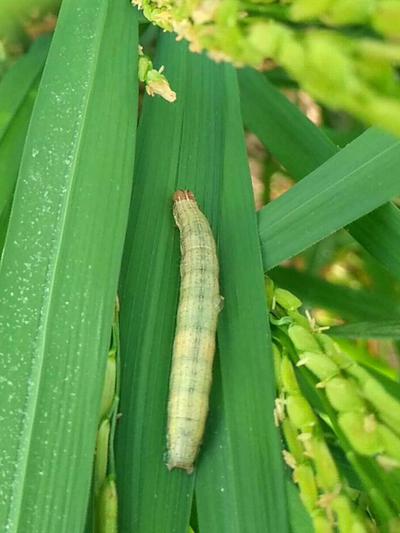Fall Armyworm
Spodoptera frugiperda
Insect
In a Nutshell
- Feeding damage on all plant parts.
- Frass can be found on leaves.
- Caterpillar has a Y-like pattern on the forehead and 4 dots on the back.
Can also be found in
Symptoms
The larvae of the fall armyworm cause damage by feeding on all plant parts. Young larvae initially eat one side of the surface of the leaf tissue, leaving the opposite layer intact (window feeding). Seedlings can be fed upon up to the destruction of buds and growing points. Larger larvae leave a characteristic row of perforations and ragged margins on leaves, as well as lines of larval frass. They can also cut the base of the plant or attack the reproductive and young fruit. In the case of heavy infestation, fall armyworm larvae can cause extensive loss of leaves.
Recommendations

Organic Control
Wasp parasitoids include Cotesia marginiventris, Chelonus texanus and C. remus. The most common parasitoid fly is Archytas marmoratus. Predators include ground beetles, spined soldier bugs, flower bugs, birds or rodents. Bio-insecticides containing neem extracts, Bacillus Thuringiensis or Baculovirus Spodoptera, as well as Spinosad or Azadirachtin can be sprayed. In maize, red sand, rock salt, charcoal powder or fly ash put in the whorl deters the larvae from feeding and kill them (100 %, 98 %, 90 and 80 % efficacy, respectively).

Chemical Control
Always consider an integrated approach with preventive measures together with biological treatments if available. Recommended insecticides include esfenvalerate, chlorpyrifos and lambda-cyhalothrin. Farmers are also advised to go for poison bait based on these insecticides for adult larvae.
What caused it?
Eggs are laid in tight clusters of 100-300 on the undersides of the leaves, usually covered with scales. The larvae are light tan or green to nearly black, with stripes running along the flanks and a yellowish line along the back. The moth has white transparent hind wings and brown front wings mottled with lighter and darker marks. Each forewing has a noticeable whitish spot near the extreme tip. Diet and temperature determine the length of the different life cycle phases. Cool, wet springs followed by warm, humid weather favor the life cycle of the insect.
Preventive Measures
- Plant more resilient plants.
- Monitor the moth's presence and mass-catch them with light or pheromone traps (10 traps/ha).
- Plant early to avoid peak populations.
- Weed control is recommended.
- Harvest early to avoid consistent damage.
- Plow the land to expose larvae and pupae to high temperatures.



